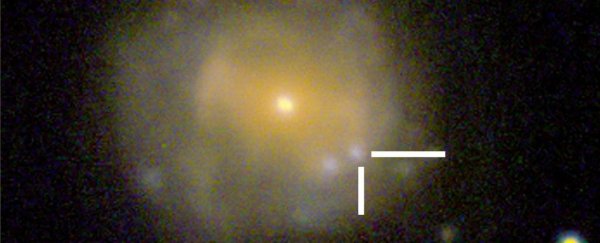The cause of a mysterious cosmic kaboom – so bright it led to the classification of a new type of space explosion – may have now been revealed.
According to an analysis of the 2018 event, nicknamed "the Cow" (AT2018cow), it was likely an unusual kind of core-collapse supernova that led to the formation of a compact cosmic object, either a neutron star or a small black hole.
"We have likely discovered the birth of a compact object in a supernova," says astronomer Dheeraj Pasham of MIT's Kavli Institute for Astrophysics and Space Research.
"This happens in normal supernovae, but we haven't seen it before because it's such a messy process. We think this new evidence opens possibilities for finding baby black holes or baby neutron stars."
The Cow was detected on 16 June 2018, and was immediately fascinating. It was incredibly brief, and incredibly bright, around 100 times brighter than a typical supernova. That's so bright that the Cow was initially thought to be coming from within the Milky Way. Astronomers were stunned when they figured out it actually emanated from a galaxy 200 million light-years away.
Since the Cow, more explosions with a similar profile have been identified. They have been named Fast Blue Optical Transients, of FBOTs, and astronomers have been keen to get to the bottom of what causes them.
One potential option was a tidal disruption flare from a black hole consuming another dense object, such as a white dwarf; or from an intermediate-mass black hole greater than 850 times the mass of the Sun stripping material from a passing star.
Another option was a type of core-collapse supernova, in which a stellar core, no longer supported by the outward pressure of fusion, collapses under its own gravity into an ultra-dense object.
One way to determine which of these scenarios was the most likely was to take a closer look at the X-ray data, so this is what Pasham and his team did.
"This signal was close and also bright in X-rays, which is what got my attention," Pasham says. "To me, the first thing that comes to mind is, some really energetic phenomenon is going on to generate X-rays. So, I wanted to test out the idea that there is a black hole or compact object at the core of the Cow."
The data they analyzed was from NASA's X-ray telescope Neutron Star Interior Composition Explorer (NICER), which is attached to the International Space Station. After the detection of the Cow, NICER observed the object for about 60 days to collect X-ray data on its post-nova behavior.
In those data, the researchers found that something within the Cow was pulsing in soft X-rays, letting out a burst every 4.4 milliseconds, for the entire duration of the 60-day observing period. This periodicity sets pretty stringent constraints on the physical mechanism producing the X-rays; whatever it is can be no larger than 1,000 kilometers (621 miles) across.
"The only thing that can be that small is a compact object – either a neutron star or black hole," Pasham says.
The strength of the signal also places constraints on the object's mass. It can be no greater than 800 times the mass of the Sun, which rules out tidal disruption of an intermediate-mass black hole. This also suggests a core-collapse.
The periodic pulsations could be produced by different mechanisms, depending on what the compact object is. If it's a neutron star, 4.4 milliseconds could be its spin rate. If it's a black hole, the emission could be produced by fallback – material blasted out during the supernova falling back into the newborn black hole, generating X-ray emissions.
There are still some unanswered questions that remain with either model, however. For a neutron star, the narrowness of the frequency range of the emissions is difficult to explain. For a black hole, characteristics such as the X-ray brightness and stability are difficult to explain.
Future studies of the Cow and other FBOTs could help to resolve these outstanding problems.
And they could also help us better understand some of the most extreme objects in the Universe.
"Whenever there's a new phenomenon, there's excitement that it could tell something new about the Universe," Pasham notes.
"For FBOTs, we have shown we can study their pulsations in detail, in a way that's not possible in the optical. So, this is a new way to understand these newborn compact objects."
The research has been published in Nature Astronomy.
